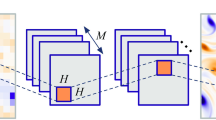Abstract
We describe a simple method for estimating turbulent boundary layer wall friction using the fit of measured velocity data to a boundary layer model profile that extends the logarithmic profile all the way to the wall. Two models for the boundary layer profile are examined, the power-series interpolation scheme of Spalding and the Musker profile which is based on the eddy viscosity concept. The performance of the method is quantified using recent experimental data in zero pressure gradient flat-plate turbulent boundary layers, and favorable pressure gradient turbulent boundary layers in a pipe, for which independent measurements of wall shear are also available. Between the two model profiles tested, the Musker profile performs much better than the Spalding profile. Results show that the new procedure can provide highly accurate estimates of wall shear with a mean error of about 0.5% in friction velocity, or 1% in shear stress, an accuracy that is comparable to that from independent direct measurements of wall shear stress. An important advantage of the method is its ability to provide accurate estimates of wall shear not only based on many data points in a velocity profile but also very sparse data points in the velocity profile, including only a single data point such as that originating from a near-wall probe.








Similar content being viewed by others
References
Blackwelder R, Haritonidis J (1983) Scaling of the bursting frequency in turbulent boundary layers. J Fluid Mech 132:87–103
Chauhan KA, Nagib HM, Monkewitz PA, On the composite logarithmic profile in zero pressure gradient turbulent boundary layers, AIAA Paper No. AIAA 2007–532
Clauser FH (1956) The turbulent boundary layer. Adv Appl Mech 4:1–51
Coles DE (1968) The Young person’s guide to the data. Computation of turbulent boundary layers, 1968 AFOSR-IFP Stanford Conference, vol. 2, Stanford University
Fernholz HH, Finley PJ (1996) The incompressible zero-pressure-gradient turbulent boundary layer: an assessment of the data. Prog Aerosp Sci 32:245–311
Fourguette D, Modarress D, Taugwalder F, Wilson D, Koochesfahani M, Gharib M, Miniature and MOEMS flow sensors, AIAA Paper No. AIAA-2001–2982
Fourguette D, Modarress D, Wilson D, Koochesfahani M, Gharib M, An optical MEMS-based shear stress sensor for high reynolds number applications, AIAA Paper No. AIAA-2003–0742
Kline SJ, Reynolds WC, Schraub FA, Runstadler PW (1967) The structure of turbulent boundary layers. J Fluid Mech 30:741–773
McKeon BJ, Li J, Jiang W, Morrison JF, Smits AJ (2004) Further observations on the mean velocity distribution in fully developed pipe flow. J Fluid Mech 501:135–147
Musker AJ (1979) Explicit expression for the smooth wall velocity distribution in a turbulent boundary layer. AIAA J 17:655–657
Ong L, Wallace JM (1998) Join probability density analysis of the structure and dynamics of the vorticity field of a turbulent boundary layer. J Fluid Mech 367:291–328
Österlund JM (1999), Experimental studies of zero pressure-gradient turbulent boundary-layer flow. Ph.D. thesis, Department of Mechanics, Royal Institute of Technology, Stockholm
Österlund JM, Johansson AV, Nagib HM, Hites MH (2000) A note on the overlap region in turbulent boundary layers. Phys Fluids 12:1–4
Spalart P (1988) Direct simulation of a turbulent boundary layer up to Re θ = 1410. J Fluid Mech 187:61–98
Spalding DB (1961) A single formula for the Law of the Wall. J Appl Mech Trans ASME Ser E. 83:455
Wei T, Schmidt R, McMurtry P (2005) Comment on the Clauser chart method for determining the friction velocity. Exp Fluids 38:695–699
Zanoun E, Durst F, Nagib H (2003) Evaluating the Law of the Wall in two-dimensional fully developed channel flows. Phys Fluids 15:3079–3089
Acknowledgments
We thank Professor Hassan Nagib for providing us with the Österlund data set. The authors are grateful to Professor Donald Coles for discussions and many helpful suggestions.
Author information
Authors and Affiliations
Corresponding author
Rights and permissions
About this article
Cite this article
Kendall, A., Koochesfahani, M. A method for estimating wall friction in turbulent wall-bounded flows. Exp Fluids 44, 773–780 (2008). https://doi.org/10.1007/s00348-007-0433-9
Received:
Revised:
Accepted:
Published:
Issue Date:
DOI: https://doi.org/10.1007/s00348-007-0433-9




